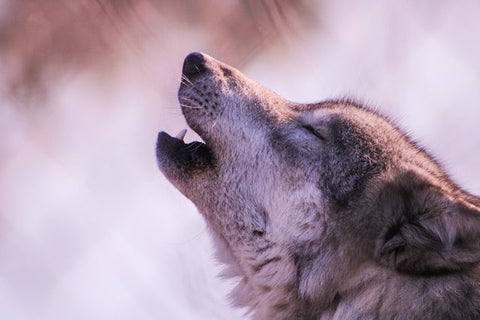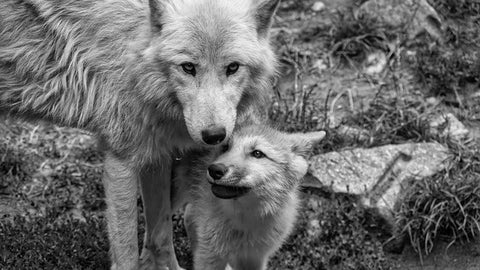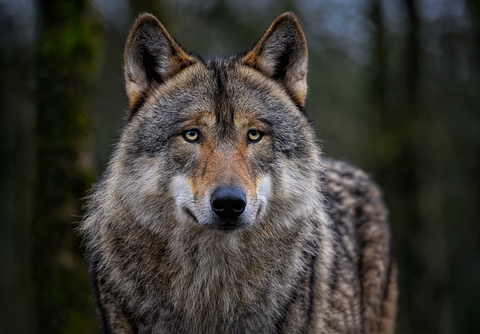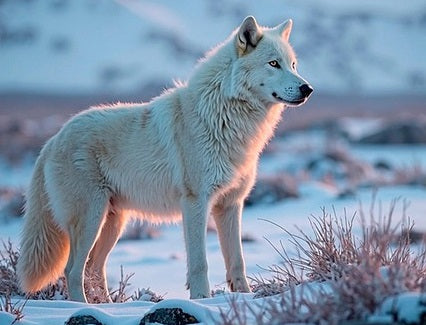
All about the Japanese wolf (Okami)
of reading - words
What is the Japanese wolf?
Physical description and behavior of Canis lupus hodophilax
The Japanese wolf , known scientifically as Canis lupus hodophilax , was about 90 centimeters long and weighed an estimated 8 to 15 kilograms . Considered one of the smallest wolves in the world, it had an appearance that made it more like a wild dog .
Its coat was dense, varying in shades from gray to brown, with silver highlights. It had a shorter muzzle than other wolves and larger ears, well adapted for detecting prey in the dense Japanese forests.
Behaviorally, Canis lupus hodophilax was a solitary animal or one that lived in small packs , capable of traveling long distances in search of food. Its howls were distinctive, often associated with local superstitions .
Natural habitat and historical range
The Japanese wolf lived primarily in the mountains and remote forests of Japan. The islands of Honshu , Kyushu , and Shikoku were its natural territory. These areas, covered with dense forests and alpine meadows, provided an ideal refuge for this secretive animal.
Its presence once extended across the country's mountain range. However, with massive deforestation in the Meiji era and urbanization, its habitat rapidly declined. The wolf gradually found itself confined to isolated regions, far from human activity.

Food and role in the Japanese ecosystem
The Canis lupus hodophilax played a key role in the ecosystem by maintaining a natural balance . It fed mainly on small mammals such as hares , deer , and wild boars . This diet helped regulate the population of these animals, preventing overpopulation, which was a source of agricultural devastation.
Furthermore, the Japanese wolf was an efficient scavenger , helping to clear the forest of dead animal carcasses. This ecological contribution reinforced its essential place in the food chain and the balance of its environment.
Etymology and cultural significance of Okami
Origin of the word “Okami” and its kanji
The word “Okami” (狼) means wolf in Japanese. However, its usage goes far beyond simply referring to an animal. In kanji,狼is composed of characters that evoke strength , loyalty , and sacred protection .
In some regions, the term Okami also symbolized a protective deity , a direct link to Shinto folklore where wolves were seen as guardians of forests and villages.
Differences between the Japanese wolf and the wolf in general in folklore
In Japanese mythology and folklore , the wolf is distinguished by its role as a protector and spiritual guide , in contrast to its image as a feared predator in many Western cultures.
The Japanese wolf was seen as a divine messenger capable of driving away evil spirits and ensuring a bountiful harvest . Many legends tell of how wolves guided lost travelers in the mountains or protected villages from wild boar attacks.
Over the centuries, this perception has given rise to rituals and sacred objects, such as wolf jewelry , often worn as talismans to attract luck and protection. If you are passionate about this world, the Terre des Loups boutique offers a unique selection to discover them.
Japanese wolf-inspired tattoos, like those available in our wolf tattoo collection, also reflect these beliefs. They often symbolize strength , loyalty , and resilience , in homage to this animal that continues to mark Japanese culture.
A species gone, but never forgotten
The first historical and fossil traces of Canis lupus hodophilax
Canis lupus hodophilax has left fossil evidence indicating that it lived in Japan for at least tens of thousands of years . These remains, found in the mountainous regions of Honshu, Shikoku, and Kyushu, show perfect adaptation to a rugged and isolated environment.
The first written records date back to the Nara era (710-794) , where it appears in historical texts and local beliefs. At the same time, archaeological deposits reveal wolf bones in sites linked to rituals or human burials, testifying to their central place in traditions.
Specific reasons for the disappearance: hunting and deforestation
The disappearance of the Japanese wolf is attributed to two major factors:
Intensive hunting : During the Meiji era (1868-1912), Japan's modernization led to an exaggerated fear of wolves, which were perceived as dangerous predators. The government even introduced financial rewards for their capture or killing , encouraging mass hunting.
Deforestation : With rapid industrialization, Japan's forests were converted into farmland. This destruction of its natural habitat reduced its hunting grounds and exacerbated conflicts with human populations.
These practices have not only contributed to the disappearance of the Japanese wolf but have also irreversibly modified local ecosystems, reinforcing the fragility of certain species.

The disappearance of the Japanese wolf: an ecological turning point
Official date and context of the extinction
The last official Okami specimen was shot in 1905 in Nara Prefecture. This event marked the tragic end of one of the iconic symbols of Japanese wildlife.
Its extinction came at a time of rapid transition for Japan, which sought to adopt modern agricultural methods while combating potential threats to crops. Wolves, although playing a regulatory role in the ecosystem, were classified as pests rather than protected.
The ecological consequences of the disappearance of the Okami
The extinction of the Okami had major ecological impacts:
- Overpopulation of herbivorous species such as deer and wild boar, which are now damaging forests and crops.
- Partial collapse of the forest ecosystem , with cascading consequences for other species.
- Loss of genetic biodiversity , by eliminating a natural predator capable of maintaining ecological balance.
This void left by the wolf disrupted the ecology of the Japanese mountains, which never truly recovered. Today, modern solutions such as the reintroduction of similar species or alternative methods of animal control are being considered.
Symbolism around extinction: between regret and hope
Modern attempts to preserve and protect similar species
Although the Okami has disappeared, Japan is trying to preserve its ecological heritage. Several initiatives aim to protect closely related wolf species , such as the Mongolian gray wolf , and to restore destroyed natural habitats.
Some organizations advocate for the reintroduction of wolves as an ecological solution to regulate wildlife, although this idea remains controversial. Raising public awareness through documentaries and exhibitions has also helped revive interest in this iconic species.
In the world of merchandise, wolf jewelry celebrates this extinct animal by combining symbolism and style, offering everyone the opportunity to maintain a tangible connection with the spirit of Okami .
Okami in Japanese collective memory
The extinction of the Okami remains a topic of cultural reflection . Through legends and folk tales, this wolf is now perceived as a lost guardian of Japan. Its representations appear in traditional arts, notably through wolf sculptures, paintings, and decorative objects.
Educational toys, such as wolf toys , also help to pass on its history to new generations. By exploring this figure, the Japanese reinterpret their relationship with nature and the preservation of their animal heritage.
This symbol persists in the hearts of those who, even today, carry the Okami as a lesson of respect for wildlife and ecological balance.

Why does the Japanese wolf still fascinate today?
Meaning of Japanese Wolf Designs in Tattoos
The Japanese wolf is often depicted in wolf tattoos as a symbol of protection , loyalty , and resilience . Associated with sacred mountains and kami (deities), it embodies a spiritual connection between humans and nature. Designs often blend the wolf with elements of Japanese folklore, such as cherry blossoms or traditional masks, adding cultural depth to the design.
Jewelry, decoration and other derivative objects inspired by Okami
The Japanese wolf inspires a wide variety of modern objects, from wolf jewelry to wolf decor items. These creations convey the spirit and strength of the Okami while respecting tradition.
- Jewelry : Wolf-shaped pendants and rings symbolizing strength and wisdom.
- Decoration : Statues, paintings, or handicrafts that pay homage to Japanese culture and extinct wildlife.
These objects have become a way for Japanese mythology enthusiasts to keep this symbol alive.
How to perpetuate the legacy of Okami?
Local and international initiatives to preserve the memory of Canis lupus hodophilax
Several Japanese and international associations work to promote the heritage of Okami . They organize exhibitions , support research on its ecological role and raise awareness about biodiversity conservation .
Animal sanctuaries and wildlife conservation initiatives in Japan are also drawing inspiration from the history of the Japanese wolf to protect endangered species.
Why continue to be inspired by the values associated with the Japanese wolf?
The Okami reminds us of the importance of living in harmony with nature and respecting its balance. Its memory is an essential lesson in an era where deforestation and species extinction are major issues.
Drawing inspiration from the values of Okami also means celebrating notions such as strength , protection , and resilience , timeless qualities that continue to captivate current generations.






